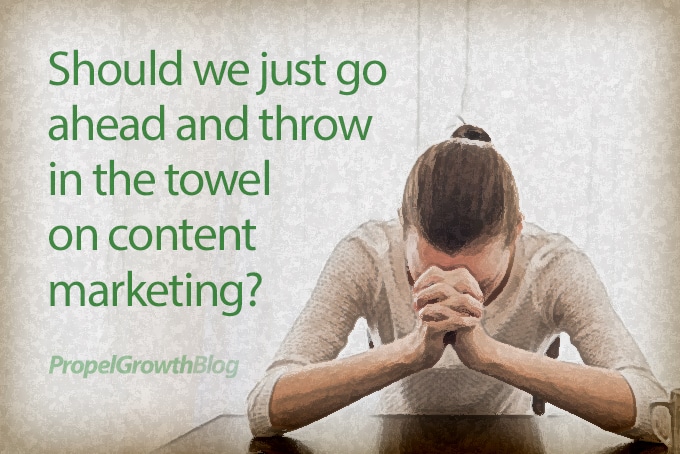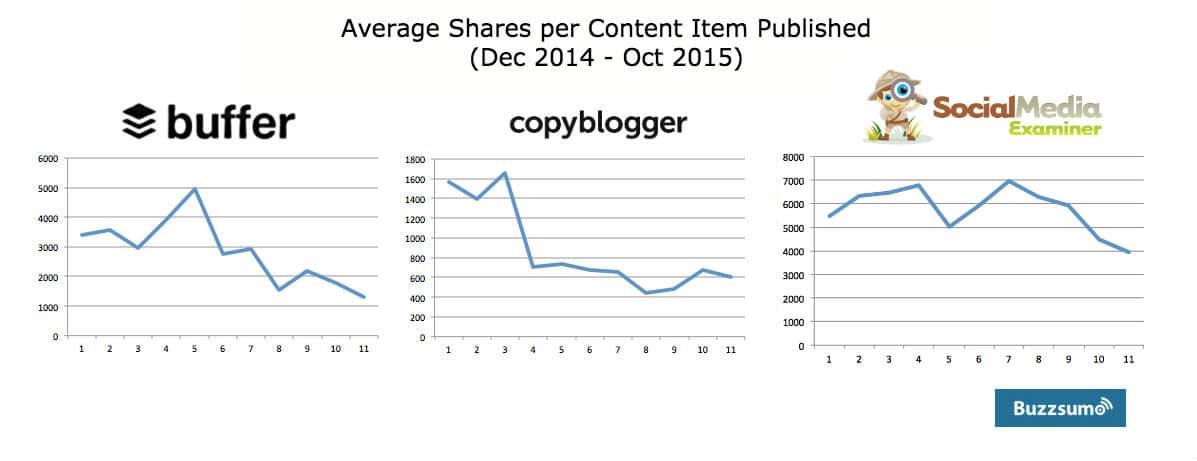![]()

Note: This article is the first in a series. It is primarily directed at companies with a limited addressable market selling to a business audience with a relatively complex buying process. Their product requires a considerable investment from the buyer (over $100K per annum). Their buyers need substantial education before committing and must convince more than one member of a buying committee.
Today, marketers are facing increasing pressure to demonstrate a real contribution to revenue. At the same time that this pressure is building, the effectiveness of content marketing is beginning to wane. We appear to have entered the “Trough of Disillusionment” according to Gartner.
This year, the number of marketers who consider their content marketing effective dropped by 20% over last year, according to CMI’s 2016 Content Marketing Benchmarks, Budgets, and Trends research. 70% of respondents were either neutral or said their marketing is not effective in accomplishing their goals.
I think there are four issues contributing to this problem:
- The impact of content shock
- Continued challenges in customer-centricity
- Improved approaches for measuring ROI
- Lack of effective and timely sales follow-up
This article explores the first issue. I’ll be publishing several more articles to address the other challenges and provide insights on how to address them and make your marketing more effective at accomplishing your goals.
Content Shock
Mark Schaefer first coined the term “Content Shock” in January 2014. He predicted that as more marketers publish more content, the volume produced will exceed audiences’ appetite to consume. We simply don’t have time to consume all the content out there.
And he’s right. In 2014, CMI and Marketing Profs research found that 93% of marketers were using content marketing. They redefined the term in the 2015 study, and the number dropped to 88%, but that’s still a lot!
And those marketers are creating loads of content. According to PQ Media, global content marketing spend exceeded $145B dollars in 2015 and is expected to reach $313B by 2019. That’s a massive amount of content being produced!
Mark’s prediction has come true. Content shock has indeed set in. So far, its effect is being felt most severely in industries that were early to adopt content and social media marketing approaches. For example, in November 2015, BuzzSumo reported that three of the top blogs in the marketing industry, CopyBlogger, Social Media Examiner and Buffer, all saw massive drops of more than 50% in traffic from social referrals over the first 9 months of 2015.

Image source: Buzzsumo. Used with permission.
Engagement is also dropping. TrackMaven “analyzed the output of marketing content and corresponding interactions from…8,800 brands…throughout 2013 and 2014.” They observed 7.2B interactions across 13.8M pieces of content. In that time period, content generated by the brands increased by 78%. But during the same timeframe, the number of interactions by followers FELL by 60%. So increasing the volume of content actually delivered lower engagement. According to TrackMaven, “Marketers are getting better at distributing content, but are not getting better at creating content worth distributing.”
Content Marketing and The Trough of Disillusionment
As usual, Robert Rose and Joe Pulizzi from Content Marketing Institute are on top of the issue.
In Content Marketing – It’s Going to Get Weird, Joe Pulizzi cites Gartner’s Hype Cycle for Digital Marketing. Essentially, Gartner (and Joe) think content marketing has risen very quickly to the “Peak of Inflated Expectations.” Nearly every B2B and most B2C firms now have a sense of what content marketing is about. Many firms saw early successes with these methods. This was especially true for those early adopters who were able to build a substantial audience before the volume of content got overwhelming.
But now, if nearly every company is using it, then content marketing itself is no longer a differentiator. At the same time, marketers are under pressure to deliver financial results instead of vanity metrics. So what was “working” before based on measures such as “likes,” “shares” and raw traffic now needs to meet tougher, sales-oriented goals.
So we’re sinking into the “Trough of Disillusionment.” It’s going to take some time to figure out what works in this new normal, and many marketers will fail. But eventually, new leaders will climb out of the trough to reach the “Slope of Enlightenment” where they’ll start gaining traction again.
Disillusionment Sets In
In his article, Joe points out, “The reasons why marketers are disillusioned with content marketing are varied: Companies focus on campaigns instead of ongoing programs, publish content that’s brand-focused rather than audience-focused, or produce content that’s undifferentiated in any way. Goals like “engagement” don’t connect to long-term results, and the lack of audience building in any way shocks and astonishes me. Here’s what I believe: Now is when we will witness the greatest content marketing failures of all time.”
But, he reassures, “we also will see some of the greatest success stories of our time.”
Scott Lum commented on Joe’s blog, “I think the weird times will be good for the industry. The learning experiences will make us stronger. We’ll learn to how to put better governance in place, have less trial and error of endless technologies (or maybe not), and customer-centricity will become a culture instead of a buzzword.”
Robert Rose introduced Joe’s article with this: “Here’s the thing that will either comfort you or keep you up at night. Ready for it?
“Nobody has this figured out. Nobody. Whether you’re a small business or a Fortune 100 global conglomerate, we’re all feeling our way, exploring, on a journey together.”
Rose continues, “As we enter this trough of disillusionment, the successes will come to those who are patient. It won’t be enough to get early wins. We have to sustain the effort. Those who do will still be the outliers, the case studies. The difference will be the failures. You’ll start to hear more and more about them.”
We’ll Hear More About Failures
I agree with Robert and Joe. We will start hearing more about the failures. And as we hear about them, so will your executive team. So it’s incumbent on marketers to be prepared. Acknowledge that the tide is shifting. We’re all in the process of figuring out what works in this new normal. Be prepared to talk about what you’re going to do about these problems. But don’t assume you can or should have all the answers.
Should We Give Up and Go Back to Old Marketing Methods?
The challenge of not knowing what works in marketing is not new. Robert Rose explored the issue of measuring the ROI of marketing in this article. He writes, “Marketing-performance measurement is not a new challenge. It’s not as if we lost something we once had in the 1960s. Marketers have been talking about the struggle to measure marketing’s performance for as long as it’s been around. Mercantilist John Wannamaker famously said in the late 1800s, ‘I know half my advertising is wasted; the trouble is I don’t know which half.’”
The Old Ways Are Dead or Dying
We can’t just throw in the towel on content marketing and go back to the old ways. Print media is dying a slow and painful death. Pew Research reports that print ad revenue has continued its 10th straight year in a downward slide. Dozens of newspapers and magazines have shut down or gone all digital.
But digital doesn’t offer good options either. Approximately 33% of Americans and 198 million people globally now use ad blockers. That number grew by 41% in the US and 82% in the UK last year.
Even if they’re not using blockers, Internet users have gotten very good at not even seeing banner ads. Each of us is served more than 1700 banner ads per month. Click rates for display ad campaigns average 0.06% (meaning 1 in 6000 ads are clicked). Approximately 50% of mobile ad clicks are accidental. Advertisers also don’t get a lot of control over where their ads show up. 72% of campaigns had their ad shown adjacent to inappropriate content.
Continued Challenges in Being Customer-Centric
Patiently sticking to what we’ve always done also won’t get us through this. We have to become compulsively customer-centric in our messaging.
People don’t engage because they want to engage with your brand. They engage when they find content educational, useful or entertaining.
One of the key problems with content continues to be a lack of awareness of what prospective customers need in order to make well-informed buying decisions. Many marketers still don’t have a firm grasp on the customer’s situation, business problems, buying process, and informational needs. It still shocks me how few marketers actually get out to talk with real customers and prospects on a regular basis. Honestly, I don’t know how they think they can possibly make content that will deliver results without first-hand customer insight.
Get Comfortable With the Chaos
But we also have to get comfortable with our chaotic, shifting reality. In an interview on the Late Show, James Spader described his character in The Blacklist – “Put in the most chaotic and uncomfortable circumstances, he’s quite comfortable. I think that part of it is a lack of fear, which I wish we had more of in our society today.”
We can’t just shut down our efforts in fear. We need to focus on getting to know our customers and gathering as much customer insight as possible. And we need to get comfortable with the fact that what we know today might not be true tomorrow. We have to continually gather customer insights, experiment with insight-based approaches, observe the results carefully, and amplify the things that are working. The winners in content marketing, and marketing in general, will be the ones who become comfortable with the chaos and persist in the cloud of unknowing, paying close attention to outcomes and constantly evolving.
Get a Coach
We provide coaching to help you move past that trough of disillusionment to prepare and execute a more effective marketing strategy. Click to learn more about our coaching service.
More To Come
Over the next few weeks, I’ll be writing more about these issues and what you can do about them. The 2nd article in the series discusses how being more customer-centric affects results.
The 3rd article will address new approaches to ROI measurement. The 4th article will talk about how marketing can facilitate better sales follow-up with marketing generated leads to improve the conversion rates from MQLs to SQLs.






